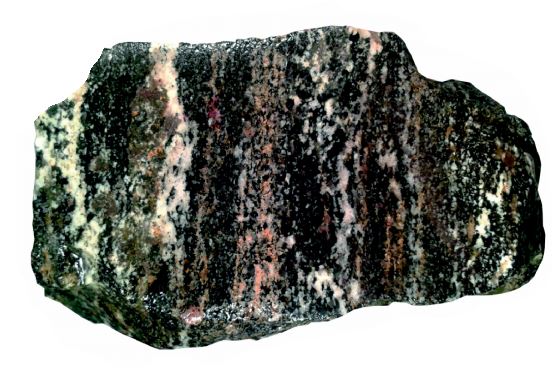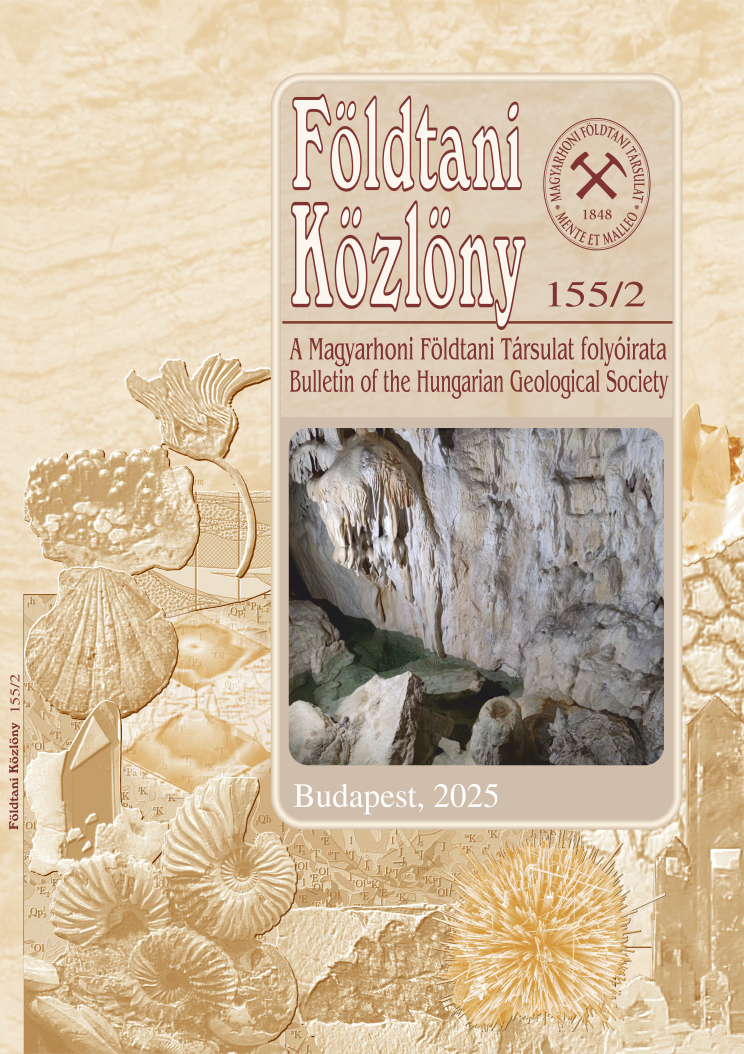Dumortierite-bearing gneiss, clinohumite-bearing marble and scapolite-bearing amphibolite in Dunavarsány
Abstract
In the Pleistocene alluvium of the Danube, near the surface in the whole section along the river above Dunaújváros, some bigger (even more than 1 m in diameter) blocks were detected. These blocks with irregular disposition and a wide range of compositon and shape are embedded in the varied compositional gravels. The main occurences of this assemblage are the Little Hungarian Plain and the South Pest Plain, the best known localities are the gravel pits around Dunavarsány and Délegyháza. The origin of the blocks have been investigated for a long time, but the accurate source haven’t been described yet, therefore the mean of their transportation is a matter of debate until now. To give the final answer to this question a petrographic study was made of different exotic metamorphic rocks, each of them contains a rare, unique mineral. These blocks were found in the gravel pit of Aqua ltd. (Dunavarsány). The examined blocks show dumortierite-bearing gneiss, clinohumite-bearing marble and scapolite-bearing amphibolite composition. The diagnostic dumortierite-bearing cordierite-tourmaline-andalusite-sillimanite-garnet gneiss, the clinohumite-bearing olivine-spinell-apatite-tremolite-chlorite-phlogopite dolomitic marble and the scapolite-bearing prehnit-actinolite-diopside amphibolite outcrops in the Austrian part of the Bohemian Massif. These localities are on the steep banks of the Danube, close to each other. According to field observations, comparative polarising and scanning electron microscopic analyses, Raman-spectroscopy and literary analogies the place of origin of the blocks can be clearly located. Based on the composition, the size and the shape of the blocks, the „river ice” mechanism during the Pleistocene is the most responsible factor for such transportation.
References
BODA, J. 1982: Adatok a Duna pleisztocén kori eróziójához Dél-Buda területén – Földtani Közlöny 112, 455-458.
BÓDI, B. 1938: A Budapest-környéki harmadkori kavicsok kõzettani vizsgálata, különös tekintettel a levantei kavicsképzõdményekre. (Petrographische Untersuchung der tertiären Schotterablegerungen aus der Umgebung von Budapest.) – Földtani Közlöny 68, 180-207.
BORS, V. – VÖRÖS, A. 2008: A Dunavarsány környéki pleisztocén kavicsösszlet kőzettömbjeinek előzetes kőzettani vizsgálati eredményei – Kézirat Tudományos Diákköri Dolgozat, ELTE TTK, Budapest, 2008
BURJÁN, B. 2002: A Pesti-síkság kavicsos üledékeinek szemcseeloszlási vizsgálata, Földtani Közlöny 132: 161-173.
BURJÁN, B. 2003: Budapest-környéki idős Duna-teraszok nehézásvány-tartalmának cluster-analízis alapú statisztikai vizsgálata, Földrajzi Értesítő (1952-2008) 52:(3-4) 171-185.
CEMPÍREK, J., NOVÁK, M. 2006: Mineralogy of dumortierite-bearing abyssal pegmatites at Starkoč and Běstvina, Kutná Hora Crystalline Complex, Journal of the Czech Geological Society – 51/3-4. https://doi.org/10.3190/jcgs.998
COOKE, R. A., O’BRIEN, P.J. 2001: Resolving the relationship between high P–T rocks and gneisses in collisional terranes: an example from the Gföhl gneiss-granulite association in the Moldanubian Zone, Austria – Lithos 58: 33–54 https://doi.org/10.1016/s0024-4937(01)00049-4
CSÖLLEY, E. V. 2014: A dunavarsányi pleisztocén kavicsösszlet exotikus vulkáni tömbjeinek petrográfiai vizsgálati eredményei – Kézirat, Diplomamunka ELTE TTK Kőzettan-Geokémiai Tanszék p. 167
DIONNE, J-C. 1968: Morphologie et sedimentologie glacielles litoral sud du Saint-Laurent –
Zeitschrift Für Geomorphologie, Suplementband 7. 56–84.
FRANKE, W. 1989: Tectonostratigraphic units in the Variscan belt of Central Europe, Geological Society of America Special Papers 230, 67-90. https://doi.org/10.1130/spe230-p67
FUCHS, Y., ERTL, A., HUGHES, M. J., PROWATKE, S., BRANDSTÄTTER, F., SCHUSTER, R. (2005): Dumortierite from Gföhl unit, Lower Austria: chemistry, structure and infra-red spectroscopy, European Journal of Mineralogy 2005, 17. 173-183. https://doi.org/10.1127/0935-1221/2005/0017-0173
HAHN, Gy. 1975. A magyarországi hegységelőteri, dombvidéki és medencebeli löszök és löszszerű üledékek morfogenetikája és kronológiája – Kézirat, Kandidátusi értekezés
HALAVÁTS, GY. 1895: Az Alföld Duna–Tisza közötti részének földtani viszonyai - MÁFI Évkönyve 11.
HLAWATSCH, C. 1911: Über einige Mineralien der Pegmatit-gänge im Gneise von Ebersdorf bei Pöchlarn, Niederösterreich, Verhandlungen der Geologischen Reichanstalt, 11, 259.
HORUSITZKY, H. 1917: A győri ipar– és hajózó csatorna geológiai szelvénye. – Magyar Királyi Földtani Intézet Évi Jelentése 1916-ról. Budapest. pp. 619–626.
HORVÁTH, F., BADA, G., WINDHOFFER, G., CSONTOS, L., DOMBRÁDI, E., DÖVÉNYI, P., FODOR, L., GRENERCZY, Gy., SÍKHEGYI, F., SZAFIÁN, P., SZÉKELY, B., TIMÁR, G., TÓTH, L., TÓTH, T. 2006: A Pannon-medence jelenkori geodinamikájának atlasza: Euro-konform térképsorozat és magyarázó. A Pannon-medence és környezete digitális terepmodellje –Magyar Geofizika 47(4), 133-137.
JÁMBOR, Á. 2010: Hömpölyök -óriás kavicsok- előfordulása a hazai pleisztocén folyóvízi képződményekben – Földrajzi Közlemények 134/2, 159-171.
JASKÓ, S. & KORDOS, L. 1990: A Budapest–Adony–Örkény közötti terület kavics formációja – MÁFI Évi Jelentése 1988-ról, 153–167.
JOBSTMANN, B. 1912: Auffindung von Dumortierit im anstehenden Pegmatit bei Ebersdorf (bei Pöchlarn), Tschermaks Mineralogische und Petrographische Mitteilungen 1912. 120.
KIESEWETTER, L. & KNOBLOCH, G. 2003: Die Minerale des Raumes Spitz/Donau – MEFOS, 14/26, 4-22.
KÁZMÉR, M. 2007: Paleogén ősföldrajz az alpi-kárpáti régióban. – MTA Doktori értekezés. Kézirat. 129. pp.
KRIVÁN, P. 1973: A periglaciális Dunaüledékek közelhegységi törmelékanyagának eredete a Dunakanyartól a Pesti Síkságig – Földtani Közlöny 103. 136–144.
KRUMBEIN, W. C. 1941: Measurement and geological significance of shape and roundness of sedimentary particles – Journal of Sedimentary Petrology, 11, 64-72. https://doi.org/10.1306/d42690f3-2b26-11d7-8648000102c1865d
LEMBERKOVICS, V. 1998: Gránát – turmalin tartalmú granitoid kőzetek a Délegyháza környéki pleisztocén kavicsteraszból – Kézirat Tudományos Diákköri Dolgozat, ELTE TTK Kőzettan-Geokémiai Tanszék 49 pp.
LINDSEY, D.A., LANGER, W. H., VAN GOSEN, B. S. 2007: Using pebble lithology and roundness to interpret gravel provenance in piedmont fluvial systems of the Rocky Mountains, USA. Sedimentary Geology, 199/3–4, 223–232
LÖFFLER, E. & KOLITSCH, U. 2011: Die Mineralien der Loja bei Persenbeug, Niederösterreich (II). Mineralien-Welt. 22 (4): 51-62
LŐRENTHEY, I. 1906: Budapest pannóniai és levantei korú rétegei és ezek faunája — Matematikai és Természettudományi Értesítő, Magyar Tudományos Akadémia, Budapest 296-342.
MÁTÉ, L. 2005: A dunavarsányi Aqua Kft. kavicsbányájában termelt felsőpleisztocén folyóvízi eredetű kavicsos összlet andezitkavicsainak statisztikai és kőzettani vizsgálata – Kézirat, Diplomamunka ELTE TTK Kőzettan-Geokémiai Tanszék 136 p.
MICSINAI, D. – MOLNÁR, M. 2010: Dél-Pesti síkság pleisztocén kavicsösszletének vizsgálata Dunavarsányban – Kézirat, Tudományos Diákköri Dolgozat, ELTE TTK Kőzettan-Geokémiai Tanszék, Budapest, 2010
MILLER, K. L., SZABÓ, T., JEROLMACK, D. J., & DOMOKOS, G. 2014: Quantifying the Significance of Abrasion and Selective Transport for Downstream Fluvial Grain Size Evolution. Journal of Geophysical Research: Earth Surface, 119 (11), 2412-2429.
MOGYORÓSI, T. 2013: A dunavarsányi pleisztocén üledékes összlet kainozoikumi, prekvarter ősmaradvány-tartalmú kavicsainak, hömpölyeinek első vizsgálatai – Kézirat, Diplomamunka, ELTE TTK Kőzettan-Geokémiai Tanszék 70 p.
NAGY B. 2002: A felszínfejlődés késő-pleisztocén-holocén jellegzetességei a Sajó-Hernád hordalékkúpon. Földtani Közlöny 132/különszám, 93-100
NEUMAYER, R. (1980): Neue Mineralfunde aus dem Waldviertel – Mitteilungen der Österreichischen Mineralogischen Gesellschaft 127, 30-32.
PÉCSI, M. 1959: A magyarországi Duna-völgy kialakulása és felszínalaktana. – Földrajzi Monográfiák 3. Akadémia Kiadó, Budapest. 345 p.
RACEK, M., ŠTÍPSKÁ, P., PITRA, P., SCHULMANN, K. & LEXA, O. 2006: Metamorphic record of burial and exhumation of orogenic lower and middle crust: a new tectonothermal model for the Drosendorf window (Bohemian Massif, Austria). Mineralogy and Petrology, 86 (3-4), 221-251. https://doi.org/10.1007/s00710-005-0111-7
RÓNAI, A., 1985. Az Alföld negyedidőszaki földtana – Geologica Hungarica Series Geologica. 21
SCHAFARZIK, F. 1914: Jegyzõkönyv az 1913. nov. 5-i szakülésrõl – Földtani Közlöny 40, p. 88.
SCHAFARZIK, F. 1918: A budapesti Duna paleohydrográfiája – Földtani Közlöny 48. 184 - 200.
SÜMEGI, P. 2001: A negyedidőszak földtanának és őskörnyezetének alapjai – JATE Press, Szeged. 262 p.
SZABÓ, J. 1872: Egy morena képződmény a Mátrában – Földtani Közlöny 2. 233–241.
SZABÓ, J. 1879: Budapest geológiai tekintetben. – Különlenyomat a Magyar Orvosok és Természetvizsgálók 1879-iki Vándorgyűlésének munkálataiból, Budapest, 116 p.+ 1 földtani térkép és 3 tábla
SZABÓ, J. 1888: A jégkorszak hatása Magyarországon – Földtani Közlöny 18. 367–371.
SZEBERÉNYI, J. 2010: Geomorphological environment of boulders and grain-size analysis og fravel sheets in the Southern Börzsöny, Hungary – Hungarian Geographical Bulletin 59 (4) 371-392.
T. BIRÓ, K., JÓZSA, S., J. SZABÓ, K., M. VIRÁG, ZS. 2013: Duna: A nagy szállítószalag. Archeometriai Műhely 2013/X./1., 33-49.
VÁCZI, B., SPRÁNITZ, T. 2014: Új magyarországi ásványfajok a Duna pleisztocén kavicsösszletéből és földtani jelentőségük, – Kézirat, Tudományos Diákköri Dolgozat, ELTE TTK Kőzettan-Geokémiai Tanszék, Budapest
VARGA, M. 2010: Magyarországi andaluzitos gránit hömpölyök petrográfiája (Dunavarsány, Nyugati-Mecsek térségben) – Kézirat, Diplomamunka, ELTE TTK, Kőzettan-Geokémiai Tanszék, 125 p.
VÍGH, CS. 2010: Granulitok a Duna pleisztocén korú kavicsanyagából – Kézirat, Diplomamunka, ELTE TTK Kőzettan-Geokémiai Tanszék 124 p.
ZAYDAN, A. & SCHARBERT, H. G. 1983: Petrologie und Geochemie moldanubischer metamorpher Serien im Raume Persenbeug (südwestl. Waldviertel) – Jahrbuch der Geologischen Bundesanstalt, 126/1, 181-199.
ZSEMLE, F, TÖRÖK, K, JÓZSA, S, KÁZMÉR, M. 2001: Granulite pebbles from the Upper Pleistocene terrace of the Danube at Délegyháza, Hungary – Földtani Közlöny, 131/3-4, 461-474
webes hivatkozás: http://static.panoramio.com/photos/original/19598823.jpg
















